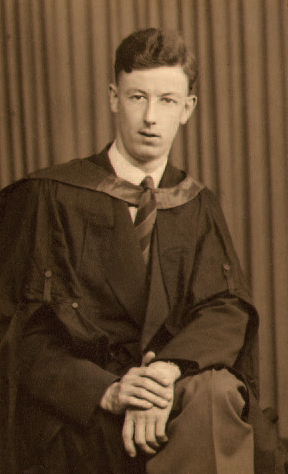Crystallography in Canada
104 Rothwell Drive, Ottawa, Ontario, K1J 8L9, Canada
Reprinted from CNCC Newsletter No 1 (Canadian National Committee for Crystallography) September 2009
|

|
Fig 1: Eric Gabe (1957)
|
| |
|

|
Fig 2: Eric Gabe with Picker diffractometer
controlled by DEC PDP-8 (circa late 1960's)
|
|
|
 |
Fig 3: Left to right: Maureen Gabe, Eric Gabe
and Margaret Pippy (circa 2007).
Photo taken by Carol Huber and
provided by Margaret Pippy.
|
I graduated from Cardiff University with a B.Sc in 1957 and continued on to postgraduate work in crystal structure analysis under the direction of Dr D.F. Grant, obtaining a Ph.D in 1960.
During that time computers were becoming available and it was possible to attempt 3-D analysis of medium sized organic compounds for the first time, though it was a very tedious process. There were no integrated systems for structure analysis and it involved the use of several different computers. Thus, the output from a structure-factor calculation on one computer, was incompatible with calculating a Fourier map on another computer, and would require manual re-typing of the required paper-tape input. Time on the computers, which were in different cities, always seemed to be allotted to crystallographers during the night. At five in the morning, realising that the paper-tape going into one side of the reader was not emerging on the other, was not the happiest experience. Typically, the whole process might take a year.
I then moved to the Pure Physics Division of N.R.C. in Ottawa as a post-doctoral fellow under Dr W.H. Barnes, though I worked mainly with Farid Ahmed using programs which he had written for an IBM 650. After a brief stint in London using a Ferranti Mercury machine - from midnight to 6 am - I moved to Dr A.L.Patterson's lab in Philadelphia where I wrote many programs for the in-lab IBM 1620, a rather strange machine which used a decimal structure rather than binary.
In 1966 I moved back to Ottawa and became involved in the automation of a Picker diffractometer in the Mines Branch labs of the Department of Energy, Mines and Resources; the first such machine in Canada. This work used a DEC PDP-8 minicomputer and, because of its speed, I was able to use the otherwise idle computer time while the instrument was scanning a reflection to calculate absorption corrections by Gaussian quadrature. This led me to realise that such machines could be used for all aspects of structure analysis. In 1972 I moved back to the Chemistry Division at NRC and began work on what ultimately was to become the NRCVAX package. The first programs were written in machine code for the PDP-8e computer, the basic version of which had 4-K 12-bit words and a 1 microsecond cycle time. It was possible to add more memory, up to 32-K at great cost, but the only auxiliary storage available was on magnetic DEC-Tape which was very slow. Fortunately, in about 1969, DEC introduced the OS-8 operating system using a 1.6 mega-word disc and a Fortran compiler with an excellent overlay structure. In my opinion this single-user operating system was far better than many later systems. Working in collaboration with Dr D.F. Grant, Dr A.C. Larson, Prof Yu Wang and Dr P.S. White, we were able to develop a complete Fortran package for data collection and analysis using the PDP-8e. Initially, floating-point operations used software emulators and calculations were rather slow. However, the introduction of floating-point hardware speeded things up enormously and it became possible to solve and refine a 20 to 40 atom structure in less than a working day. The only real restriction was caused by the size of the memory in full-matrix calculations and block-diagonal methods were used.
The diffractometer program, DIFRAC, migrated to control CAD-4 machines using PDP-11 computers and the analysis package moved to the PDP-11 60. Memory size still imposed a limit on full-matrix least-squares and, in fact, was more severe on the PDP 11 than on the earlier and seemingly smaller machine, because of the less efficient overlay scheme. In the early 70s most structure analysis was done on large mainframes and many people had difficulty in believing that it could be done on in-lab minicomputers. I remember being told at a meeting that such things could not be done on a PDP-8! When the system moved to the PDP-11 we encountered portability problems, with compiler inconsistencies and different input / output handling. Programs were modified accordingly, but we realised that the code needed to be made more portable. When the system migrated to the DEC VAX in the mid-70s (and to the increasingly available PCs using Windows) size restrictions were removed and the code itself was revised to use a safe subset of Fortran 77, sometimes referred to as 'Pidgin' Fortran. Areas where compilers in different machines still caused problems were isolated to a small set of routines which could be controlled by system specific parameters. These include graphics, input/output, Boolean and time/date routines. In this way potential problem code can be isolated and easily dealt with if the need arises. The infamous, and grossly overstated, Y2K problem was dealt with by changing one line of code. The NRCVAX system is not, and was never meant to be, a 'black box', though it can be used quite successfully with the built in defaults. Users with crystallographic knowledge however, can use the many options available to solve and refine difficult structures.
|



